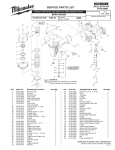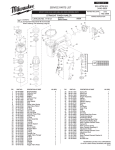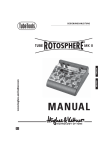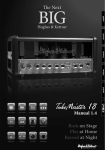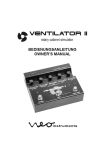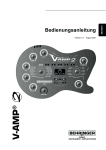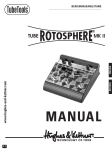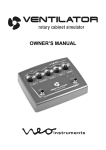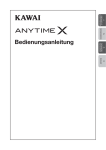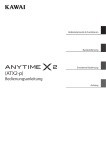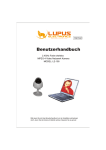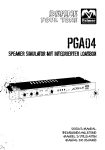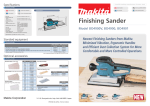Download bedienungsanleitung owner's manual
Transcript
BEDIENUNGSANLEITUNG OWNER’S MANUAL INHALT Seite I EINLEITUNG II. ANSCHLÜSSE UND EINSTELLUNGEN III. BEDIENELEMENTE IV. SWITCH MODES V. TECHNISCHE DATEN VI. SICHERHEITSHINWEISE VII. GARANTIEBEDINGUNGEN 3 4 6 13 14 15 16 Die in dieser Bedienungsanleitung benutzten Markennamen Hammond®, Leslie® sind geschützte Warenzeichen der Hammond-Suzuki Corporation. 2 I. EINLEITUNG Wir beglückwünschen Sie zum Kauf des Neo Instruments VENTILATOR II. Um alle Möglichkeiten des Gerätes ausschöpfen zu können, empfehlen wir Ihnen diese Anleitung vollständig zu lesen und zum späteren Nachschlagen aufzubewahren. Auch die Verpackung sollte aufbewahrt werden, falls ein späterer Versand des Geräts nötig wird. Der VENTILATOR II ist ein digitales Effektgerät zur Simulation eines Leslie 122 Rotorkabinetts bei Abnahme mit 3 Mikros (Bass mono, Horn stereo). Es ist für Orgel und Gitarre gleichermaßen geeignet und besitzt folgende herausragende Merkmale: - aufwändige Modeling Algorithmen, exakte Nachbildung des Rotoreffekts eines 122er Leslies - unabhängige Simulation von Bass- und Hochtonrotor - genaue Reproduktion der mechanischen Eigenschaften - Speakersimulation für authentischen 122er Frequenzgang - Frequenzweiche 800Hz wie beim Original - Rotorgeschwindigkeiten und Beschleunigung anpassbar - Drive Sektion simuliert Verzerrung / Endstufensättigung des Leslie Röhrenamps - variabler Mikrofonabstand der virtuellen Mikrofone - True Bypass Relaisschaltung - Speaker Simulation für Wiedergabe über Gitarrenamp abschaltbar - Anschluss für Remote Fußschalter / Halfmoon Switch / Expression Pedal - Slow / Fast / Stop Funktion - einfache, analoge Bedienung - stabiles Stahlblechgehäuse, versenkte Knöpfe 3 II. ANSCHLÜSSE UND EINSTELLUNGEN Der VENTILATOR II besitzt einen Stereo Eingang und einen Stereo Ausgang. Mit dem Lo / Hi Schalter kann die Eingangsempfindlichkeit an die Signalquelle angepasst werden. Der VENTILATOR II kann sowohl zwischen Instrument und Verstärker bzw. Mischpult als auch an einem Einschleifweg angeschlossen werden. IN L, IN R / MONO Eingangsbuchsen für ein Stereosignal (Orgel, Keyboard, Gitarre). Für die Effekterzeugung wird allerdings nur das Signal der IN R / MONO Buchse genutzt. Deshalb Mono Instrumente unbedingt hier anschließen! Im Bypass werden beide Buchsen stereo durchgeschleift. LO / HI Dieser Schalter schaltet die Empfindlichkeit der Inputs um. In der Regel ist die Stellung Lo sowohl für Orgel / Keyboards als auch Gitarre richtig. Nur für sehr leise Gitarren oder Keyboards mit schwachem Output wird es nötig sein auf Hi umzuschalten. Der Ausgangspegel bleibt in beiden Einstellungen konstant, da das Ausgangssignal automatisch angepasst wird. Zur Aussteuerungskontrolle dient die Overload LED. Overload LED Diese LED zeigt an, ob der maximale Eingangs – oder Ausgangspegel der Schaltung erreicht ist. Um bestmöglichen Rauschabstand und Auflösung des AD Wandlers zu gewährleisten, sollte man das Eingangssignal soweit aufdrehen, bis die LED bei Lautstärkespitzen anfängt zu leuchten. Dann dreht man das Eingangssignal wieder soweit leiser, bis die LED nicht mehr angeht. Nun ist die optimale Aussteuerung erreicht. 4 OUT L, OUT R / MONO Der VENTILATOR II besitzt einen Stereoausgang. Wenn das Gerät an ein Mischpult angeschlossen wird, sollten die Panoramaregler am Mischpult auf maximal links bzw. rechts gedreht sein, um ein natürliches, räumliches Effektsignal zu erzielen. Wird nur ein Monosignal benötigt (z.B. in einem komplexen Mix, bei Verstärkung über Bühnenmonitor oder Gitarrenverstärker) sollte nur der Ausgang R/MONO benutzt werden. REMOTE An diese Buchse kann der optional erhältliche Ventilator Remote bzw. Remote II Fußschalter, ein Handschalter vom Typ Hammond CU-1 oder ein Expression Pedal (z.B. Yamaha FC-7) angeschlossen werden. 12V DC Zur Spannungsversorgung hier ausschließlich das mitgelieferte Netzteil (12V DC, 0,5A) anschließen. Der VENTILATOR II kann nicht mit Batterien betrieben werden. UNBEDINGT BEACHTEN: Um störungsfreien Betrieb zu gewährleisten sollten Sie alle Anschlüsse vornehmen, bevor Sie das Netzteil anschließen. 5 III. BEDIENELEMENTE Obwohl der VENTILATOR II ein digitales Gerät ist, ist die Bedienung ähnlich einem analogen Effektgerät und daher übersichtlich und leicht verständlich. Um sich mit dem Gerät vertraut zu machen, empfiehlt sich als Ausgangspunkt folgende Einstellung: - HI / LO Gain Schalter auf Lo (nicht gedrückt) - Fast Speed, Balance, Mix/Dist Lo, Mix/Dist Hi, Slow Speed, Acceleration und Level auf Mittelstellung - Drive auf Linksanschlag (aus) - Für Orgel den MODE Parameter auf KEY (Rechtsanschlag), für Gitarre auf GIT2 (Mittelstellung) stellen - REMOTE auf Rechtsanschlag (aus) III.1. TASTER, LEDs BYPASS Mit diesem Taster wird der Rotoreffekt an- und ausgeschaltet. Im Bypassbetrieb erlischt die zugehörige rote LED (= Effekt aus) und das Eingangssignal wird per Relais auf die Ausgänge geschaltet (True Bypass). SLOW / FAST Dieser Taster schaltet die Geschwindigkeit des Rotoreffekts abwechselnd auf langsam oder schnell. Bass- und Hochtonrotor laufen wie beim Original unsynchronisiert in leicht unterschiedlichen Geschwindigkeiten. Auch die Zeiten für Beschleunigung / Abbremsen sind unterschiedlich, und zwar für den Bassrotor deutlich länger. 6 STOP Dieser Taster stoppt beide Rotoren komplett. Es wird immer die gleiche Stopposition angefahren (Rotoren strahlen nach vorn). SPEED HI / LO Die aktuelle Geschwindigkeit der Rotoren wird jeweils durch eine LED (Bassrotor = LO / gelb, Hochtonrotor = HI / rot) angezeigt. III.2. POTENTIOMETER Der Ventilator II besitzt fünf Regler um verschiedene Parameter des Effekts zu steuern. Jeder Regler hat eine Hauptfunktion (Beschriftung orange) und eine Zweitfunktion (Beschriftung weiß). Um zwischen den Funktionsebenen zu wechseln, den Bypass und Slow/Fast Taster zusammen drücken. Die Aktivierung der Zweitfunktionen wird durch Blinken der Speed LEDs angezeigt (2x pro Sekunde). Die Taster Bypass, Stop und Slow/Fast sind dabei weiterhin aktiv. Um zu den Hauptfunktionen zurückzukehren, nochmals den Bypass und Slow/Fast Taster zusammen drücken. Die Einstellungen der Zweitfunktionen werden gespeichert und bleiben auch nach dem Ausschalten erhalten. III.2.1 Potentiometer Haupfunktionen FAST SPEED Der Fast Speed Regler variiert die Geschwindigkeit für den Bassrotor und Treblerotor wenn der Effekt auf FAST geschaltet wird. Linksanschlag des Reglers bewirkt langsamere Geschwindigkeiten, Rechtsanschlag entsprechend schnellere: 7 FAST Bass 2,60Hz – 7,8Hz (6,5Hz) Horn 2,72Hz – 8,16Hz (6,8Hz) In Stellung 2.00 Uhr (Werte in Klammern) entsprechen die Geschwindigkeiten einem durchschnittlichen 122er Leslie. BALANCE Das Balance Poti regelt das Lautstärkeverhältnis von Bass und Hochtonrotor. Man kann es wie eine Art Equalizer benutzen, um den Sound an verschiedene Eingangssignale oder den musikalischen Kontext anzupassen. Auch eine Anpassung an den Verstärker / Monitor kann damit erfolgen. Durch Drehen nach rechts (von der Mittelstellung aus) werden die Bassfrequenzen abgesenkt, bzw. durch Drehen Richtung Linksanschlag entsprechend die höheren Frequenzen. DRIVE Dieser Regler aktiviert die interne Röhrensimulation des VENTILATOR. Um die Drive Sektion bestmöglich zu nutzen, sollte man zunächst den Input optimal aussteuern, wie unter „Overload LED“ beschrieben. Dann wird das Volume Pedal oder Poti am Instrument auf Maximum gebracht und der Drive Regler am VENTILATOR auf die gewünschte maximale Verzerrung eingestellt. Mit dem Volume Pedal oder Poti kann die Verzerrung nun komfortabel und ausdrucksstark beim Spielen zwischen clean und verzerrt geregelt werden. Die Drive Sektion ist pegelkompensiert, d.h. der Ausgangspegel ändert sich kaum, wenn der Drive Regler weiter aufgedreht wird. 8 MIX / DIST LO Dieser Regler kombiniert zwei Parameter. Der MIX Parameter (erste Hälfte des Regelwegs) regelt die Modulationstiefe des Bassrotors. Damit lässt sich der Effekt abschwächen. Linksanschlag bedeutet kein Effekt vom Bassrotor. Der Distance Parameter (zweite Hälfte des Regelwegs) regelt den Abstand des virtuellen Bassrotor Mikrofons. Je weiter der Regler im Uhrzeigersinn aufgedreht wird, umso näher steht das Mikrofon am Leslie. Bei Rechtsanschlag des Reglers enthält der Sound viel Amplituden Modulation, vergleichbar einer Abnahme auf der Bühne, wenn das Mikrofon ganz nah am Leslie steht. Dreht man den MIX/DIST LO Regler in die Mitte, wird der Sound diffuser mit weniger Amplituden Modulation, ähnlich einem Setup im Studio, wenn das Mikrofon weiter weg steht. MIX / DIST HI Dieser Regler funktioniert ähnlich wie MIX / DIST LO, nur diesmal für den Hochtonrotor. Der MIX Parameter (erste Hälfte des Regelwegs) regelt das Verhältnis von Direktsignal und Effektsignal des Hochtonrotors. Dadurch lässt sich der Effekt dosiert einsetzen. Linksanschlag bedeutet kein Effekt vom Hochtonrotor. Anstelle des Effekts ist das direkte Eingangssignal zu hören (in stereo wenn beide Buchsen genutzt werden). Der Distance Parameter (zweite Hälfte des Regelwegs) regelt den Abstand der virtuellen Hochtonrotor Mikrofone. Je weiter der Regler im Uhrzeigersinn aufgedreht wird, umso näher stehen die Mikrofone am Leslie. Bei Rechtsanschlag des Reglers enthält der Sound viel Amplituden Modulation, vergleichbar einer Abnahme auf der Bühne, wenn die Mics ganz nah am Leslie stehen. Dreht man den MIX/DIST HI Regler in die Mitte, wird der Sound diffuser mit weniger Amplituden Modulation, ähnlich einem Setup im Studio, wenn die Mikrofone weiter weg stehen. 9 III.2.2 Potentiometer Zweitfunktionen SLOW SPEED Der Slow Speed Regler variiert die Geschwindigkeit für den Bassrotor und Treblerotor wenn der Effekt auf SLOW geschaltet wird. Linksanschlag des Reglers bewirkt langsamere Geschwindigkeiten, Rechtsanschlag entsprechend schnellere: SLOW Bass 0,12Hz – 2,51Hz (0,76Hz) Horn 0,13Hz – 2,62Hz (0,8Hz) In Stellung 10.00 Uhr (Werte in Klammern) entsprechen die Geschwindigkeiten einem durchschnittlichen 122er Leslie. ACCELERATION Hier wird die Zeit eingestellt, die beide Rotoren brauchen, um von Slow auf Fast oder von Fast auf Slow zu wechseln. Linksanschlag des Reglers bewirkt die kürzeste Beschleunigung bzw. Abbremsen, Rechtsanschlag entsprechend längere Zeiten. In Stellung 1.00 Uhr des Reglers (Werte in Klammern) entsprechen die Zeiten einem durchschnittlichen 122er Kabinett. Die Zeit, welche die Rotoren brauchen um auf STOP zu kommen ist fest eingestellt und wird vom Acceleration Regler nicht beeinflusst. SLOW > FAST Bass 0,5sec – 4,2sec - 8sec – 8sec (5,5sec) Horn 0,5sec – 0,5sec – 2sec - 8sec (1sec) FAST > SLOW Bass 0,8sec – 4,2sec - 8sec – 8sec (5,5sec) Horn 0,8sec – 0,8sec – 3,2sec - 8sec (1,6sec) 10 MODE Der Ventilator II bietet drei unterschiedliche Frequenzgänge für die Verwendung mit Orgel oder Gitarre. Diese können über die 7 – 12 und 5 Uhr Stellung des Reglers gewählt werden. Regler Mode 7.00 GIT1 Funktion neutraler Frequenzgang für die Verwendung an einem Gitarrenverstärker 12.00 GIT2 wie GIT1 aber betonte Mitten und Höhen 5.00 KEY Simulation des Leslie 122 Frequenzgangs für die Verwendung mit Orgel Je nach verwendetem Verstärker / Lautsprecher und eigenen Soundvorstellungen kann es jedoch auch bei Orgelsounds Sinn machen die GIT Einstellungen zu benutzen, bzw. bei Gitarrenverstärkern die KEY Einstellung. REMOTE Dieser Parameter bestimmt die Funktion der Remote Buchse. Wird dort eine Ventilator remote / remote II oder ein Halfmoon Schalter angeschlossen, können die Funktionen Stop / Slow / Fast ferngesteuert werden. Wird ein Expression Pedal angeschlossen kann damit stufenlos die Geschwindigkeit des Effekts oder der Effekt Mix kontrolliert werden. Die Reglerstellungen um die verschiedenen Modes auszuwählen sind 7 – 9 – 12 –3 – 5 Uhr. Regler Mode Funktion 7.00 Switch1 Stop/Slow/Fast Fernsteuerung durch Taster (Ventilator remote II) Ring - Masse = Slow / Fast, Tip - Masse = Stop 11 9.00 Switch2 Stop/Slow/Fast Fernsteuerung durch Schalter (Ventilator remote,CU-1) 12.00 Speed Geschwindigkeitssteuerung durch ein Expression Pedal. Der Regelbereich wird eingestellt durch den Slow Speed Regler (= Pedal minimum) und den Fast Speed Regler (= Pedal maximum). Wenn Slow Speed auf Linksanschlag steht, wird bei Pedal Minimum auf Stop geschaltet. Die STOP und SLOW/FAST Taster haben in diesem Mode keine Funktion. 3.00 Mix Steuerung der Parameter MIX/DIST LO und MIX/DIST HI durch ein Expression Pedal. Der verfügbare Regelbereich ist 0 bis zum eingestellten Wert der beiden MIX / DIST Regler. 5.00 Off Schaltet die Remote Buchse ab. LEVEL Mit diesem Parameter kann der Ausgangspegel des Ventilator II angepasst werden. In 12.00 Uhr Stellung des Potis ist das Effektsignal in etwa gleich laut mit dem Bypass Signal. 12 IV. SWITCH MODES Für das Verhalten der beiden Taster SLOW/FAST und STOP stellt der VENTILATOR II sechs verschiedene Modes zur Verfügung. Um diese auszuwählen hält man beim Einschalten des Geräts die SLOW/FAST Taste für 3 Sekunden gedrückt. Dadurch gelangt man in eine Edit Routine. Nun kann man mit dem STOP Taster den vorhergehenden Mode aus der Liste auswählen oder mit dem SLOW/FAST Taster den nachfolgenden. Die beiden Speed LEDs zeigen den jeweils aktiven Mode an: Lo LED blinkt 1x/sec, Hi LED aus >>> Mode1 Lo LED blinkt 2x/sec, Hi LED aus >>> Mode2 Lo LED blinkt 3x/sec, Hi LED aus >>> Mode3 Hi LED blinkt 1x/sec, Lo LED aus >>> Mode4 Hi LED blinkt 2x/sec, Lo LED aus >>> Mode5 Hi LED blinkt 3x/sec, Lo LED aus >>> Mode6 Nach der Auswahl drückt man STOP und SLOW/FAST zusammen für 2 Sekunden um die Einstellung zu speichern und zum normalen Betriebsmodus zurückzukehren. Wenn SWITCH1 für den Parameter REMOTE gewählt wurde, gelten die hier gemachten Einstellungen auch für den externen Fußschalter. MODE 1 (“122 style”) Beide Taster haben “rastende” Funktion. Für erneutes Schalten muß der Taster zuerst losgelassen und dann wieder gedrückt werden. Die FAST Einstellung hat Priorität vor STOP. MODE 2 (“760 style”) Beide Taster haben “rastende” Funktion. STOP hat Priorität vor SLOW / FAST. Man kann jedoch während STOP mit dem SLOW/FAST Taster eine „Voreinstellung“ vornehmen, die dann aktiv wird, wenn der STOP Taster erneut gedrückt wird. MODE3 Beide Taster haben “rastende” Funktion. STOP hat Priorität vor SLOW / FAST. Wenn SLOW/FAST nach STOP gedrückt wird, wird immer SLOW ausgeführt. 13 MODE 4 Beide Taster arbeiten momentan. Die Funktion wird nur ausgeführt solange der Taster gehalten wird. Die Grundeinstellung, solange keinTaster gedrückt ist, ist SLOW. MODE 5 Dieser Mode ist ähnlich dem Mode1, aber hier arbeitet der SLOW/FAST Taster momentan. Der STOP Taster hat dagegen „rastende“ Funktion. FAST hat Priorität vor STOP. MODE 6 Dieser Mode ist ähnlich dem Mode2, aber hier arbeitet der STOP Taster momentan. Der SLOW/FAST Taster hat dagegen „rastende“ Funktion. STOP hat Priorität vor SLOW/FAST. V. TECHNISCHE DATEN Signalverarbeitung Analog Digital Wandlung Digital Analog Wandlung Rauschpegel Eingangsempfindlichkeit Eingangswiderstand Ausgangspegel Ausgangswiderstand Empfohlener Anschlusswert Gewicht Abmessungen (B x T x H) Netzspannung Stromverbrauch Anschlüsse Optional 32 Bit SHARC DSP 48khz, 24 Bit 48khz, 24 Bit -80 dBA -10 dBV (Hi), 0 dBV (Lo) 1MOhm +6 dBV 100 Ohm 10 KOhm oder mehr 1,1kg (ohne Netzteil) 160 x 143 x 55mm 100V-240V, 47Hz-63Hz max.300mA Eingang L Eingang R / Mono Ausgang L Ausgang R / Mono Remote Eingang Ventilator Remote (II) Halfmoon Switch CU-1 Änderungen auch ohne Vorankündigung vorbehalten. 14 VI. SICHERHEITSHINWEISE - Gerät nicht öffnen! Es befinden sich keine vom Benutzer zu wartenden Teile im Innern des Geräts. - Zur Reinigung ausschließlich ein trockenes Tuch oder einen Pinsel verwenden. - Gerät nicht in der Nähe von Wasser betreiben. - Zur Vermeidung von Funktionsstörungen oder sogar elektrischen Schlägen das Gerät und insbesondere das Netzteil nicht Regen oder Feuchtigkeit aussetzen. - Nicht in der Nähe von Heizungen und Wärmequellen betreiben. - Gerät nicht direkter Sonneneinstrahlung aussetzen. - Nur mit dem mitgelieferten Netzteil und nur mit den angegebenen Netzspannungen betreiben. - Gerät keinen Erschütterungen und harten Stößen aussetzen. - Zum Schutz des Gerätes bei Gewitter oder wenn es längere Zeit nicht beaufsichtigt wird, sollte der Netzstecker gezogen werden. - Netzstecker niemals mit nassen Händen anfassen. - Beim Ausstecken des Netzteils immer am Stecker und nicht am Kabel fassen. Bestimmungsgemäße Verwendung Dieses Gerät ist ausschließlich zur Erzeugung von niederfrequenten Audiosignalen zu tontechnischen Zwecken bestimmt. Eine weitergehende Verwendung ist nicht zulässig und schließt Gewährleistungsansprüche gegenüber Neo Instruments aus. 15 VII. GARANTIEBEDINGUNGEN Neo Instruments gewährt eine Garantie von 12 Monaten ab Kaufdatum für alle nachweisbaren Material- und Fertigungsfehler. Die gesetzlichen Gewährleistungsansprüche werden hiervon nicht berührt. Der Garantieanspruch erstreckt sich auf die Beseitigung festgestellter Mängel durch Reparatur oder Ersatz der defekten Teile. Weitergehende Ansprüche, so insbesondere auf Wandlung oder Minderung, können erst nach erfolgloser Nachbesserung bzw. Ersatzlieferung geltend gemacht werden. Die Garantieleistung bezieht sich nicht auf Transportschäden, auch nicht auf Schäden durch Nichtbeachtung der Bedienungsanleitung, und fehlerhafter oder nachlässiger Behandlung des Gerätes. Außerdem fallen nicht unter die Garantiebestimmungen Schäden oder Fehler durch höhere Gewalt (Blitzschlag, Hochwasser, usw.) oder sonstige äußere Einflüsse, sowie mechanische Beschädigungen oder Mängel, die nicht auf Materialverarbeitungsfehler zurückzuführen sind. Sollten Defekte innerhalb der Garantiezeit auftreten, kontaktieren Sie uns bitte unter folgender Adresse: NEO Instruments Flemingstrasse 20-22 D-36041 Fulda +49 (0)661-9619805 [email protected] www.neo-instruments.de 16 17 CONTENTS Page I WELCOME II. CONNECTIONS AND SETTINGS III. CONTROLS IV. SWITCH MODES V. SPECIFICATIONS VI. SAFETY GUIDELINES VII. WARRANTY TERMS 19 20 22 28 30 31 32 The brand names Hammond® and Leslie® used in this operating manual are protected trademarks of HammondSuzuki Corporation. 18 I. WELCOME Congratulations and thank you for purchasing Neo Instruments’ VENTILATOR II. If you wish to make the most of this device’s many features and full sound-shaping potential, we recommend that you read this manual and keep it for later reference. Be sure to also save the packaging just in case you have to send it at a later date. VENTILATOR II is a digital FX device that simulates a model 122 Leslie rotary speaker cabinet mic’ed up with a stereo pair on top for the treble horn and a single mono mic below for the bass woofer. Designed to deliver great results with organ and guitar, its outstanding features include: - Sophisticated modeling algorithms and a faithful replication of the model 122 Leslie’s rotary effect - Independent emulations of bass and treble rotors - Faithful replication of the original’s mechanical properties - Speaker simulation emulating the 122’s frequency response - Same 800Hz crossover as the original - Adjustable rotary speed and acceleration - Drive section that simulates distortion / power tube saturation in the Leslie’s amp - Variable placement of virtual microphones - Relay-equipped true bypass circuit - Speaker simulation may be switched off for guitar amps - Port for a remote footswitch / half-moon switch / expression pedal - Slow / Fast / Stop switching - Rugged sheet metal chassis and recessed buttons - Simple, straightforward analog handling 19 II. CONNECTIONS AND SETTINGS VENTILATOR II comes with a stereo input and a stereo output. The Lo / Hi switch matches input gain to the signal source. You can insert VENTILATOR II between your instrument and amp or mixing console as well as into an FX loop. IN L, IN R / MONO This jacks accept stereo organ, keyboard, and guitar signals. However for the rotary effect only the IN R / MONO jack is used. Connect mono instruments here. In Bypass mode both jacks are routed to the outputs in stereo. LO / HI This switch adjusts input gain. The Lo position works for most organs, keyboards, and guitars. Only very low-output guitars and keyboards require you to switch over to Hi. The output signal is automatically compensated to ensure a constant level at both settings. The Overload LED serves as a level meter. Overload LED This LED lights up to indicate the input or output signal level has reached the circuit’s threshold. For the best possible signal-to-noise ratio and AD converter resolution, turn up the input signal until the LED just begins lighting up at signal peaks. Then back the input signal off again until the LED no longer lights up. That’s the optimum level for this device. OUT L, OUT R / MONO VENTILATOR II provides a stereo output. If you connect the device to a mixing console, turn the mixer’s panorama knobs to the far left and right to achieve a realistic-sounding spatial effect. If you need just a mono signal – say, in an elaborate composite mix or when using a stage monitor or guitar amp – tap it by plugging into the R/MONO output only. 20 REMOTE This jack accepts the optionally available Ventilator Remote / Remote II footswitches, a Hammond CU-1 type Halfmoon or a YAMAHA FC-7 type expression pedal 12V DC Connect the included AC adapter (12V DC, 0.5A) only; do not use any other wall-wart or power supply. VENTILATOR II cannot be powered by batteries. HEADS UP: To ensure flawless operation, always connect all other cords before you plug in the AC adapter. 21 III. CONTROLS Although VENTILATOR II is a digital device, it handles much like an analog effect, with similar convenience and ease of use. A good way to get to know the device is to start with this setup: - Set HI / LO GAIN switch to Lo (switch is out) - Set Fast Speed, Balance, Mix/Dist Lo, Mix/Dist Hi, Slow Speed, Acceleration and Level to the 12 o’clock position. - Turn Drive to the far left (off). - Set the MODE parameter to KEY (far right position) for an organ, and to GIT2 (12 o’clock position) for guitar. - Turn the Remote control off by switching to secondary parameter mode and setting the REMOTE knob to the far right position. III.1. SWITCHES / LEDs BYPASS This stomp-switch turns the rotary effect on and off. Its red LED lights up when the effect is actice. In Bypass the input signal is relayed to the outputs via a true bypass circuit. SLOW / FAST This stomp-switch determines the speed of the rotary effect by switching between slow and fast. As on the original, the bass and treble rotors run out of sync at slightly different speeds. Acceleration and deceleration times also differ, with the bass rotor taking much longer to speed up and slow down. STOP This switch stops the rotors completely. The Stop position is always with the rotors facing forward. 22 SPEED LO / HI One LED each indicates the respective rotor’s current speed (bass rotor = LO / yellow; treble rotor = HI / red). III.2. POTS Ventilator II features five knobs, each serving two functions. In primary mode the knobs control the parameters labeled in orange. In secondary mode the knobs control the parameters labeled in white. The secondary functions are accessed by pressing the Bypass and Slow/Fast switch simultaneously. When in secondary mode, the Speed LEDs will blink two times per second. The Bypass, Stop and Slow/Fast switch remain active. To return to primary mode just press the Bypass and Slow/Fast switch together again. Secondary parameters are stored to memory and are restored on next power up. III.2.1 Pots Primary Functions FAST SPEED The Fast Speed knob adjusts the bass and treble rotors’ speeds while the unit is in FAST mode. Twist the knob to the far left for slower speeds and to the far right for faster speeds: FAST Bass 2,60Hz – 7,8Hz (6,5Hz) Horn 2,72Hz – 8,16Hz (6,8Hz) The 2 o’clock position yield the values shown in brackets, which correspond to the speeds of an average 122 model Leslie. 23 BALANCE The Balance knob adjusts the relative volumes of the bass and treble speakers. Use it much like you would an equalizer, adapting the unit’s sound to suit different types of input signals and the musical context, amp, or monitor. Twisting it to the right from the 12 o’clock position cuts low frequencies; turning it to the left cuts higher frequencies. DRIVE This knob activates VENTILATOR II’s on-board tube simulator. To make the most of the Drive section, ensure you dial in the optimum input level as described in the section above entitled Overload LED. Then set the instrument’s volume to the maximum level and twist VENTILATOR II’s Drive knob to dial in the maximum distortion level. This lets you ride the instrument’s volume pedal or knob to control the amount of saturation, which is a convenient and musically expressive way of modulating between clean and distorted sounds on the fly. The Drive section is level-compensated; that is, the output level does not change much as you turn up the Drive knob. MIX / DIST LO This controls the mix of the lower rotor in the signal as well as the distance of the virtual mic from the rotor. The first half of the travel (from all the way counter-clockwise to center) determines the mix. At 7 o’clock (all the way counter-clockwise) there is no lower rotor simulation in the mix. Note this does not remove the bass content from the signal; it simply removes the rotary effect. You can use this to emulate the classic “Memphis style” Leslie sound. The “Memphis style” on a real Leslie is 24 achieved by unplugging the motors on the lower rotor, so that only the upper rotor spins. From center to 5 o’clock (all the way clockwise), the knob adjusts the distance of the virtual mic from the lower rotor. This is handy for decreasing the amount of AM (amplitude modulation) in the signal. Pulling the mic further back decreases the “wub wub wub” effect that can be distracting, especially when you’re playing left hand and/or pedal bass. MIX / DIST HI As with the MIX / DIST LO knob, this controls the mix of the upper rotor in the signal as well as the distance of the virtual mics from the rotor. The first half of the travel (from all the way counter-clockwise to center) determines the mix. At 7 o’clock (all the way counter-clockwise) there is no upper rotor simulation in the mix. Instead you’ll hear the direct input signal (in stereo if both jacks are used). From center to 5 o’clock (all the way clockwise), the knob adjusts the distance of the virtual mics from the upper rotor. III.2.2 Pots Secondary Functions SLOW SPEED The Slow Speed knob adjusts the bass and treble rotors’ speeds while the unit is in SLOW mode. Twist the knob to the far left for slower speeds and to the far right for faster speeds: SLOW Bass 0,12Hz – 2,51Hz (0,76Hz) Horn 0,13Hz – 2,62Hz (0,8Hz) 25 The 10 o’clock position yield the values shown in brackets, which correspond to the speeds of an average 122 model Leslie. ACCELERATION This knob adjusts the amount of time it takes both rotors to go from slow to fast and from fast to slow. Set the knob to the far left for the fastest acceleration and deceleration time. Twist it to the right and the effect will be slower to speed up and slow down. The 1 o’clock positions yield the values shown in brackets, which correspond to the speeds of an average 122 model Leslie. SLOW > FAST Bass 0,5sec – 4,2sec - 8sec – 8sec (5,5sec) Horn 0,5sec – 0,5sec – 2sec - 8sec (1sec) FAST > SLOW Bass 0,8sec – 4,2sec - 8sec – 8sec (5,5sec) Horn 0,8sec – 0,8sec – 3,2sec - 8sec (1,6sec) MODE The VENTILATOR II features three different frequency responses for the use with guitar or organ. They are accessed via the 7 – 12 –5 o’clock position of the MODE knob. Pos 7.00 Mode GIT1 Functionality neutral response for use with a guitar amp 12.00 GIT2 similar to GIT1 but with accentuated mids and highs 5.00 KEY Simulation of the Leslie 122 response for use with organ 26 Depending on the speaker, amp, and your taste in tone, the GIT settings can yield interesting results in combination with organ sounds, as can the KEY setting with guitar amps. REMOTE This parameter determines the function of the remote control jack socket. It is possible to connect a volume pedal (YAMAHA FC-7 or similar), a passive remote switch (unlatched), the VENTILATOR remote / remote II or a CU-1 Halfmoon switch. The corresponding pot positions for selecting the modes are 7 - 9 - 12 - 3 - 5 o’clock. Pos 7.00 Mode Functionality Switch1 Stop/Slow/Fast control by external unlatched switches (Ventilator remote II) Ring to Sleeve = Slow / Fast, Tip to Sleeve = Stop 9.00 Switch2 Stop/Slow/Fast control by external latching switches (Ventilator remote,CU-1) 12.00 Speed SPEED is continously controllable by an expression pedal. Available Speed range is set by the SLOW SPEED pot (=pedal minimum) and the FAST SPEED pot (= pedal maximum). If Slow Speed is set to zero, the Pedal minimum activates Stop. Slow/Fast and Stop Switches are not active in this mode. 3.00 Mix Parameters MIX/DIST LO and MIX/DIST HI are continously controllable by an expression pedal. Available range is zero up to the value set by the MIX/DIST knobs. 27 5.00 Off Turns remote control off. LEVEL Adjusts the overall output level of the Ventilator II. 12 o’clock is the default position with the effect signal’s level roughly equal to the bypass signal. IV. SWITCH MODES If the SLOW/FAST switch is pressed and held for 3 seconds on power up, the Ventilator enters an edit routine enabling the user to adjust the switch behaviour of the STOP and SLOW / FAST switch.There are 6 modes (see below) that can be stepped through by pressing the Stop (decrement) or Slow/Fast switch (increment): The Lo and Hi Leds indicate the current setting: Lo LED blinking 1x/sec, Hi LED off Lo LED blinking 2x/sec, Hi LED off Lo LED blinking 3x/sec, Hi LED off Hi LED blinking 1x/sec, Lo LED off Hi LED blinking 2x/sec, Lo LED off Hi LED blinking 3x/sec, Lo LED off >>> >>> >>> >>> >>> >>> Mode1 Mode2 Mode3 Mode4 Mode5 Mode6 Pressing Stop and Slow/Fast together for 2 seconds stores the setting and leaves the edit routine. When SWITCH1 is selected via the Remote parameter, the Switch Mode setting also affects the external remote’s switch behaviour. 28 MODE 1 (“122 style”) Both switches are latching types; press once to change speed, press again to go back to the previous setting. Selecting FAST speed overrides any setting on the STOP switch. MODE 2 (“760 style”) Both switches are latching types. The STOP mode overrides any setting on the SLOW / FAST switch. You can however “preset” a speed with the SLOW / FAST switch which becomes active when leaving Stop mode by pressing STOP again. MODE3 Both switches are latching types; STOP overrides any setting of the SLOW / FAST switch. If SLOW / FAST is pressed from STOP, SLOW will always be selected. MODE 4 Both switches are momentary (unlatched) types (press and hold). Pressing the STOP button causes the Ventilator to STOP until the switch is released. Pressing the FAST / SLOW button causes the Ventilator to run at FAST speed until the switch is released. The default mode (when neither switch is pressed) is SLOW. MODE 5 This setting is similar to MODE 1, except that the SLOW / FAST switch acts in a momentary (unlatched) manner (press and hold). STOP is a latching switch (press and release). FAST mode overrides any setting on the STOP switch. MODE 6 This setting is similar to MODE 2, except that the STOP switch acts in a momentary (unlatched) manner (press and hold). SLOW / FAST is a latching switch (press and release). STOP mode overrides any setting on the SLOW / FAST switch. 29 V. SPECIFICATIONS Signal processing Analog Digital Conversion Digital Analog Conversion Noise Level Input Sensivity Input Impedance Output Level Output Impedance Recommended Load Impedance Weight Dimensions (W x D x H) Mains Voltage Current Draw Connectors Options Subject to change without notice. 30 32 Bit SHARC DSP 48khz, 24 Bit 48khz, 24 Bit -80 dBA -10 dBV (Hi), 0 dBV (Lo) 1MOhm +6 dBV 100 Ohms 10 KOhms or more 1.1kg / 2 lbs 7 oz (without Power Supply) 160 x 143 x 55mm 100V-240V, 47Hz-63Hz < 300mA Input L Input R / Mono Output L Output R / Mono Remote Input Ventilator Remote (II) Halfmoon Switch CU-1 VI. SAFETY GUIDELINES - Do not open the device – no user serviceable parts inside! - Clean with a dry cloth or brush only. - Do not operate this device near water. - To avoid malfunctions and electric shock, do not expose the device or its AC adapter to rain or moisture. - Do not operate the unit near radiators or other heat sources. - Do not expose the device to direct sunlight. - Power the device with the included AC adapter and the indicated mains voltages only. - Do not expose the device to vibrations and hard shocks. - Pull the power plug when the device is unsupervised for longer periods and to protect it from the effects of lightning. - Never touch the power cable’s plugs with wet hands. - Always disconnect the device by pulling the plug, and not the cord. Intended Use This device is intended exclusively for generating lowfrequency audio signals used for sound-engineering purposes. Any other use is not permitted and automatically invalidates the warranty extended by Neo Instruments. 31 VII. WARRANTY TERMS Neo Instruments extends a warranty covering all verifiable defects in material and workmanship for a period of 12 months from the date of original purchase. Statutory warranty rights remain unaffected hereby. The warranty covers the remedying of manifest defects by replacing or repairing defective parts. Any other claims, in particular those for a reduction in price or cancellation of contract, may only be made after an attempt to rectify the defect or deliver a replacement has failed. The warranty does not cover damage incurred during transit, as well as damage caused by non-compliance with the operating manual and improper or negligent handling of the device. Beyond that, the warranty does not cover defects or damage caused by acts of God (including but not limited to lightning, floods, etc.) or other external influences, as well as mechanical damage or flaws that are not attributable to manufacturing defects. If defects occur during the warranty period, please contact us at the following address: NEO Instruments Flemingstrasse 20-22 D-36041 Fulda +49 (0)661-9619805 [email protected] www.neo-instruments.de 32
































